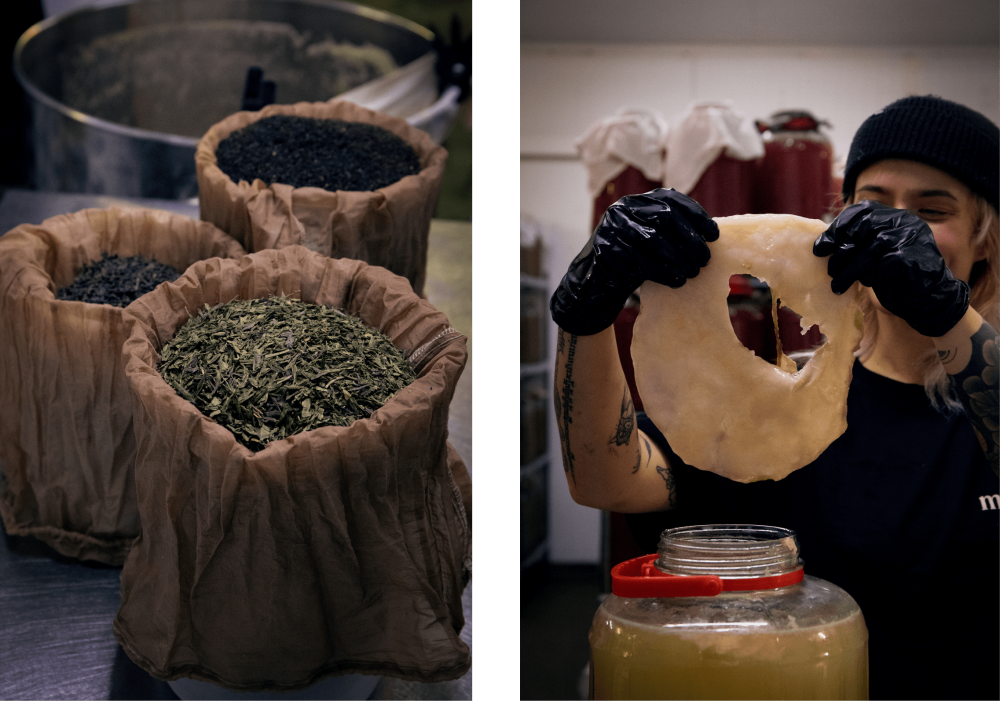At a glance, there might not appear to be many similarities between a glass of kombucha and a loaf of sourdough bread. Look a little closer and a world of similarities bubbles up from the process that unites how they are made: fermentation.
Your daily loaf and bottle of kombucha are made in similar ways, and by similar people. A dose of perfectionism and patience are required from bakers and kombucha makers alike as a large part of fermentation is about setting up the right conditions for microbial communities to get to work and, then, simply waiting.
We always knew the joys that a bottle of cold, sparkling kombucha could bring to our food. So we’ve partnered up with Momo to bring their award-winning kombucha to our bakeries.
It compliments everything somehow; a sandwich stacked with seasonal vegetables, a crumbly cookie, a flaky pastry. So when it came to finding the perfect kombucha, made with a true passion for the craft, we didn’t need to look far.
Momo was born from a love of brewing. Founders Josh and Lisa fell in love with kombucha during a trip to New York City, returning home with a newfound obsession with the slow, thoughtful ritual. They make each batch the old-fashioned way, brewing completely unfiltered kombucha in small brown jars.
It all begins with organic, loose leaf tea. Most of the sugar added is consumed during the fermentation process, making it a lighter alternative to classic fizzy drinks. No filtering is done at Momo, so all the live cultures remain in each batch. After being chilled and carbonated, the flavours are added. Usually organic, cold-pressed juice.
Humans have been harnessing the powers of fermentation for thousands of years. The first bread is thought to have been made around the Neolithic period, and kombucha is thought to have originated in northwest China around 220 BC. Be it bread, beer or kombucha, the things we make to eat, drink, and connect over, links us almost tangibly to our past. Whether done thousands of years ago or today, at home or at a craft bakery, the science of fermentation has always been the same.
When making bread, fermentation occurs when bacteria and yeast turn sugars into carbon dioxide, causing the dough to rise. Otherwise known as the ‘leavening of bread’. Kombucha is fermented tea, and requires two stages of fermentation to perfect. The process can take anywhere between a week and 60 days. The result is something gently effervescent, bracing and, much like a loaf of good bread, slightly sour.
Gut health. Microbiome. It’s being talked about more and more. Good bacteria are essential for the microbiome in our gut to thrive. There is more and more research being done into how a healthy gut can affect our bodies and minds for the better. So drinking a bottle of kombucha is a deliciously simple way to do something good for your body.
We went and visited Josh and Lisa at their production site to get a little closer to the process. In kombucha making, just as in the bakery, time and a preoccupation with perfection drives everything. Standing in front of a wall of small-batch jars of slowly-fermenting kombucha, Josh tells us, ‘If anything looks wrong and we’re not 100% happy, we just won’t bottle that jar. There are so many ways we could speed up the fermentation process, or brew at a larger scale. But we want to brew as close to homemade as possible.’ ‘It is quite a lot of work,’ Lisa admits, ‘but we decided to keep going with the old-fashioned process. We’re not cutting any corners.’
Shared values, similar passions and a taste for ancient, yet strangely familiar crafts. Kombucha and bread – or in this case, GAIL’s and Momo, may just be the perfect pairing. We’re now serving their Elderflower and Rhubarb kombuchas in our bakeries.



